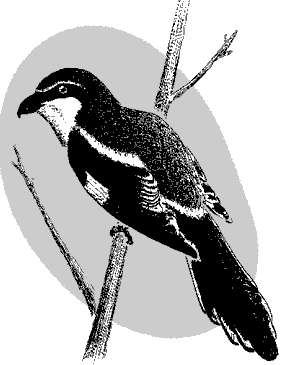Excerpts from Jim Conrad's
Naturalist Newsletter
Entry dated February 24, 2024, issued from near Tequisquiapan; elevation about 1,900m, (6200 ft), ~N20.57°, ~W99.89°; Querétaro state, MÉXICO
LOGGERHEAD SHRIKE IN SWEET ACACIA
![Loggerhead Shrike, Lanius ludovicianus on spiny Sweet Acacia, VACHELLIA [ACACIA] FARNESIANA](shrike-m.jpg)
from the October 4, 1996 entry in Jim's book The Dunes of Samayaluca. The Dunes are in northern Mexico's Chihuahuan Desert about half an hour south of the US/Mexico border between El Paso, Texas and Juárez
BUTCHER BIRD
At 10 AM a raspy call erupts from the next dune's slope. Something white perches there on a brown, decaying flower-stalk emerging from a wastebasket-size cluster of bristling, bayonet-shaped yucca leaves. The binoculars show an old friend, a bird I've known since I was a kid on the Kentucky farm, the Loggerhead Shrike, LANIUS LUDOVICIANUS.
 It's a handsome bird and it's handsome not because of colors, which are merely gray, white and black, but because of the boldness of its patterns. It's mostly gray with a white throat, black tail, and black wings with white patches that flash during flight. And shrikes wear black face masks like cartoon characters robbing banks. For beginning birders, the black mask separates it from similar-looking Mockingbirds.
It's a handsome bird and it's handsome not because of colors, which are merely gray, white and black, but because of the boldness of its patterns. It's mostly gray with a white throat, black tail, and black wings with white patches that flash during flight. And shrikes wear black face masks like cartoon characters robbing banks. For beginning birders, the black mask separates it from similar-looking Mockingbirds.
You expect hawks and owls to be hunters of small animals other than insects, but not songbirds like shrikes. Nonetheless, Loggerhead Shrikes prey on rodents and birds as well as insects. Songbirds aren't supposed to have hooked beaks like hawks and owls, but even from thirty feet away I can see this shrike's upper mandible curving downward into a conspicuous hook.
Shrikes, like all other predatory birds, have the problem of keeping their prey stabilized while they dissect their prey. However, shrikes don't have the powerful feet that owls and hawks do to hold their prey, so shrikes sometime impale and immobilize their victims on sharp things like spines and thorns. I've often found mice and grasshoppers on cactus thorns and barbed wire spines, surely the work of shrikes. In fact, I don't think I've ever seen a shrike without there being something spiky nearby.
Once in Mississippi I spotted a Loggerhead Shrike perched on a fence surrounding a suburban home's backyard garden, and I thought I'd finally seen one away from all spines. But then I noticed that the bird was perched on a chainlink fence with the top border wires snipped off, forming sharp spikes jutting into the air every inch or so.
This bird simply has an irrepressible passion for spikiness.
entry dated February 22, 2022, issued from near Tequisquiapan, elevation about 1,900m (6200 ft), Querétaro state, MÉXICO
A SHRIKE-IMPALED LIZARD
Among the spiny branches of a Sweet Acacia, or Huisache, Vachellia farnesiana, the lizard shown below had been left impaled by a Loggerhead Shrike.
![lizard impaled Sweet Acacia, VACHELLIA [ACACIA] FARNESIANA, by Loggerhead Shrike, Lanius ludovicianus](shrike-l.jpg)
Even as we walked away, the shrike flew past us into the tree with the lizard, seeming to look if we'd stolen his meal.